 |
 |
 |
| |
Sustained Virologic Response After Peginterferon alfa-2b and Ribavirin Treatment Predicts 99% Long-term Clearance of HCV at 5-Year Follow-up
|
| |
| |
Reported by Jules Levin
43rd EASL
April 23-27, 2008
Milan, Italy
M. Manns,1 K. L. Lindsay,2 S. C. Gordon,3 P. J. Pockros,4 D. Haeussinger,5 S. Hadziyannis,6 W. Schmidt,7 I. Jacobson,8 R. Barcena,9 E. Schiff,10
O. S. Shaikh,11 B. Bacon,12 P. Marcellin,13 C. Smith,14 J. G. McHutchison,15 W. Deng,16 L. D. Pedicone,16 J. K. Albrecht16
1Medizinische Hochschule, Hannover, Germany; 2Keck School of Medicine of the University of Southern California, Los Angeles, California, USA; 3Henry Ford Hospital, Detroit, Michigan, USA; 4Scripps Clinic, La Jolla, California, USA;
5Universitatsklinikum, Du_sseldorf, Germany; 6Evgenidion Hospital, Athens, Greece; 7University of Iowa Hospitals and Clinics, Iowa City, Iowa, USA; 8Weill Medical College of Cornell University, New York, New York, USA;
9Hospital Ramon y Cajal, Madrid, Spain; 10University of Miami, Miami, Florida, USA; 11University of Pittsburgh, Pittsburgh, Pennsylvania, USA; 12St. Louis University, St. Louis, Missouri, USA; 13Hopital Beaujon, Clichy, France;
14Minnesota Clinical Research Center, Plymouth, Minnesota, USA; 15Duke University School of Medicine, Durham, North Carolina, USA; 16Schering-Plough Research Institute, Kenilworth, New Jersey, USA
367 Sustained Responders to Pegintron plus ribavirin were followed for 3 to 5 years. These SRs were from 2 large clinical trials of 1700 study participants.
Author Summary
Kaplan-Meier estimate for continued sustained response over 5 years was 99% (97%-100%)
As reported for other therapies, all confirmed relapses occurred within the first 2 years of follow-up
89% of patients with normal ALT at the end of 24 weeks of follow-up in the initial studies had normal ALT at least 5 years later
During follow-up, clinical progression of liver disease was reported in 1 nonresponder; no sustained responders experienced clinical progression of liver disease
Author Conclusions
Attainment of SVR after treatment with PEG-IFN alfa-2b, with or without ribavirin, predicts long-term clearance of HCV
- 99% of patients who attained SVR maintained long-term viral clearance
These results, and those of McHutchison et al,2 suggest that successful treatment (SVR) of hepatitis C with IFN alfa-2b (with or without ribavirin) leads to clinical cure of this chronic disease
Abstract
Background and Aim: McHutchison et al (J Hepatol. 2006;44[suppl 2]:S275) showed that sustained virologic response (SVR) 24 weeks after treatment of chronic hepatitis C with interferon alfa-2b ± ribavirin (IFN±RBV) predicts long-term clearance (>5 years) of hepatitis C virus (HCV) from serum. The aim of the current study was to confirm this finding in patients treated with peginterferon alfa-2b ± RBV (PEG±RBV).
Methods: 567/1695 (33%) subjects from 2 clinical trials (Lindsay et al. Hepatology. 2001;34:395-403; Manns et al. Lancet. 2001;358:958-965) who were treated with PEG±RBV and completed 24 weeks’ follow-up were assessed annually for up to 5 years for evidence of liver disease progression and sustained undetectable HCV-RNA in serum.
Results:
366 sustained responders (SRs) and 201 nonresponders (NRs) entered the study and were followed up for a mean of 248 and 232 weeks, respectively.
85% and 62% of SRs and 77% and 50% of NRs completed 3 and 5 years of follow-up, respectively.
Four SRs relapsed during the 5-year follow-up period (2 at year 1, 1 at year 2, and 1 at year 5). Kaplan-Meier estimate for continued sustained response over 5 years was 99% (97%-100%).
Of the 209 SRs with normal alanine aminotransferase (ALT) values at the end of the initial 24-week follow-up, 187 (89%) remained normal throughout the 5-year follow-up period. Most abnormal ALT values were slightly above the upper limit of normal (ULN), and the highest elevation remained <5 times the ULN.
Clinical progression of liver disease occurred in 1 NR (bleeding varices) and in none of the SRs. Five SRs died during follow-up, and all deaths were unrelated to disease progression or PEG±RBV administration (prostate cancer, adenocarcinoma of lung, myocardial infarction, coronary embolism, ventricular fibrillation).
Serious adverse events were reported for 64 subjects: 3 events were considered by the principal investigators to be possibly related to use of PEG±RBV (papillary thyroid cancer, peripheral neuropathy/hypertension, ureteral calculi).
Conclusions: SVR 24 weeks after therapy with PEG±RBV predicts long-term clearance of HCV. These results, and those by McHutchison et al, suggest that successful treatment (ie, SVR) of hepatitis C with IFN (±RBV) leads to clinical cure of this chronic disease.
Aim
To confirm that attainment of SVR among patients with chronic hepatitis C who were treated with pegylated IFN (PEG-IFN) alfa-2b (PegIntron), with or without ribavirin, is predictive of long-term (≥5 years) clearance of HCV
Patients and Methods
Study Design
Phase 3b, multicenter, long-term, follow-up study of patients previously treated for chronic hepatitis C in 2 large, international clinical trials3,4
- Patients were treatment naive before receiving up to 48 weeks of PEG-IFN alfa-2b–based therapy
To be eligible for the present study, patients must have completed 24 weeks of follow-up in 1 of the 2 initial studies
- Patients could enroll at any time from 1.5 to 5.5 years after treatment
- No antiviral treatment was allowed during the course of the present study
Efficacy End Point
Primary efficacy variable was the durability of virologic response in patients who attained SVR
Assessments
Long-term follow-up assessments were scheduled for 1 year after the end of the 24-week follow-up period in the initial studies and then yearly for an additional 4 years
- Visit date windows were defined in accordance with the scheduled visits (Table 1) because not all patients attended visits at the scheduled times
Patients were assessed for
- Sustained undetectable HCV-RNA in serum
- Clinical evidence of liver disease progression
- Medically significant adverse events
Polymerase chain reaction (PCR) testing for HCV-RNA was performed by Schering-Plough Research Institute (SPRI) using a proprietary reverse transcriptase-PCR assay (TaqMan; lower limit of detection, <125 IU/mL) and by Quest Diagnostics, Nichols Institute, using another assay (COBAS TaqMan; Roche Diagnostics, Indianapolis, IN; lower limit of quantitation, <50 IU/mL)

Results
Patients
33% (567 of 1695) of eligible patients were enrolled in the long-term follow-up study (Figure 1)
- 366 patients were sustained responders, and 201 failed to attain sustained response (nonresponders)
-- Patient demographics and disease characteristics are shown in Table 2
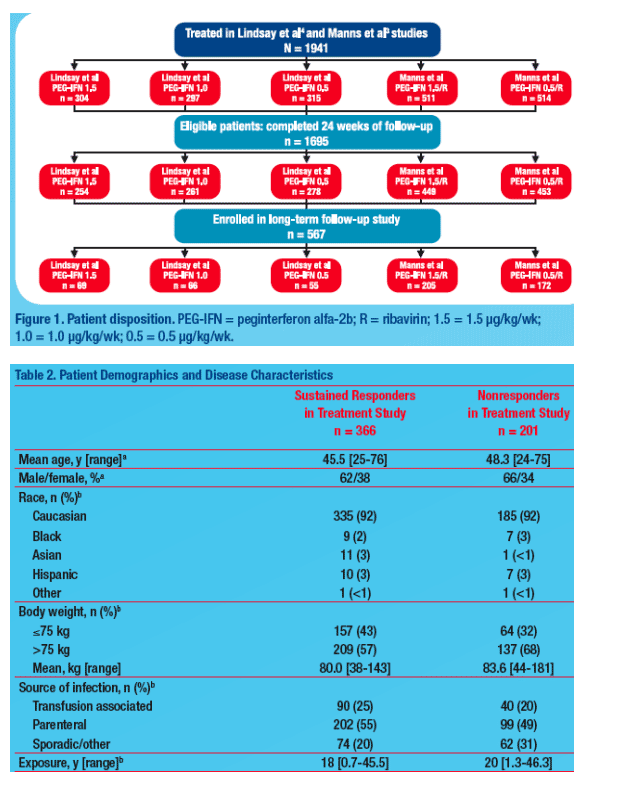
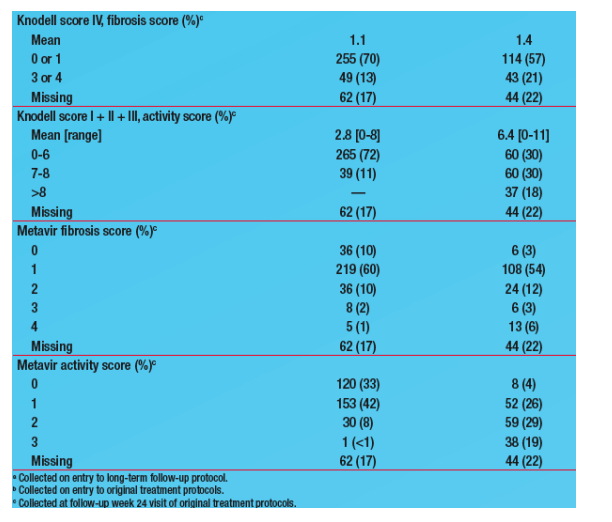
Duration of Follow-up
Sustained responders and nonresponders were followed up for means of 248 and 232 weeks, respectively
- Duration of follow-up was at least 5 years for 62% (227 of 366) of sustained responders and 50% (100 of 201) of nonresponders (Figure 2)
- Duration of follow-up was at least 3 years for 85% (311 of 366) of sustained responders and 77% (155 of 201) of nonresponders
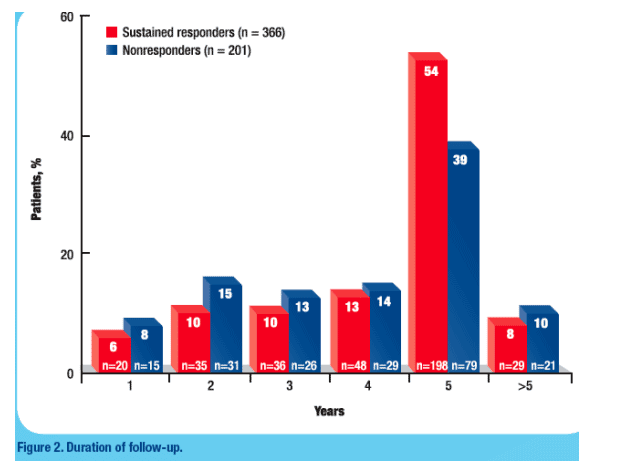
Durability of Response
Relapse included definite and possible relapse
- Definite: quantifiable HCV-RNA (>lower limit of quantitation) in serum with no subsequent undetectable HCV-RNA
- Possible: detectable, but not quantifiable, HCV-RNA in serum with no subsequent undetectable HCV-RNA
4 sustained responders relapsed during the 5-year follow-up period (Table 3)

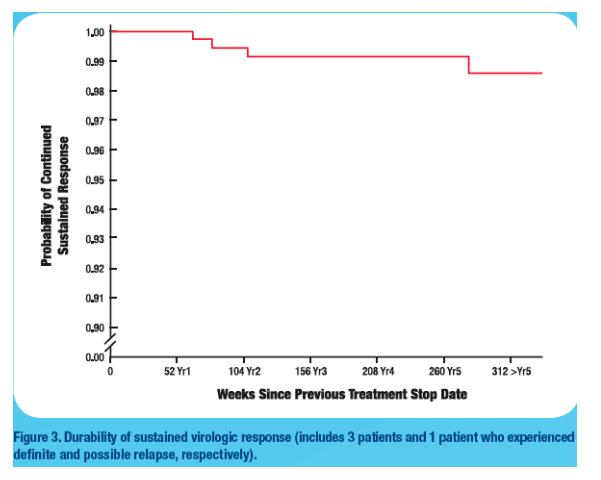
Clinical Progression of Liver Disease
No clinical progression of liver disease was reported in sustained responders during long-term follow-up
Clinical progression of liver disease (bleeding varices) occurred in 1 nonresponder during long-term follow-up
Alanine Aminotransferase Changes
Among the 209 patients who had normal ALT levels at 24 weeks of follow-up in the initial studies and were followed up for ≥5 years, 89% (187 of 209) had normal ALT levels at ≥5 years (Table 4)
-- 4 patients had abnormal ALT at the end of 24 weeks of follow-up in the initial studies, which normalized during long-term follow-up
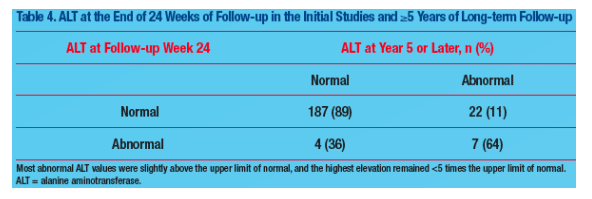
Tolerability
11% (64 of 567) of patients who previously were treated with PEG-IFN alfa-2b, with or without ribavirin, reported serious adverse events during the long-term follow-up study
- In 3 patients, the serious adverse event (papillary thyroid cancer, peripheral neuropathy/hypertension, or ureteral calculi) was considered by the principal investigators to be possibly related to PEG-IFN alfa-2b
5 patients who attained SVR died during long-term follow-up (Table 5)
- No deaths were attributed to study drugs
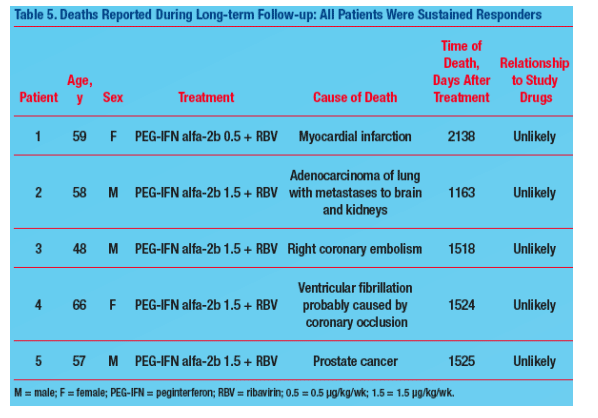
References
1. Marcellin P et al. Ann Intern Med. 1997;127:875-881.
2. McHutchison JG et al. J Hepatol. 2006;44(suppl 2):S275.
3. Manns MP et al. Lancet. 2001;358:958-965.
4. Lindsay KL et al. Hepatology. 2001;34:395-403.
|
| |
|
 |
 |
|
|